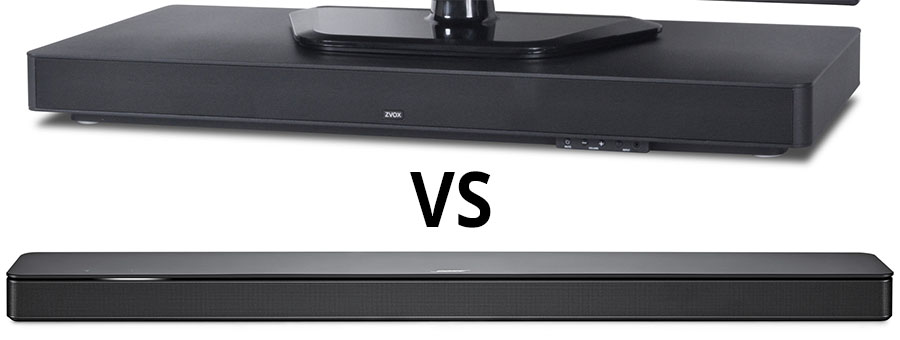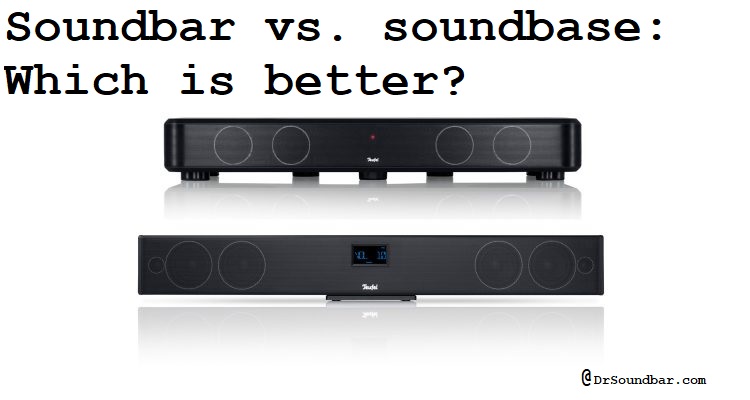Do you want to upgrade your home audio system but don’t know which device to go for? Soundbars and soundbases are two popular options, but which is better?
This comprehensive guide will help you decide the best option for your home entertainment needs. You’ll be ready to move forward with confidence, knowing exactly what to look for in either option.
When it comes to choosing audio products for your home, you have a wealth of options. Two popular choices in the sound system market are soundbars and soundbases.
Soundbars are generally tall, rectangular pieces of audio equipment that are meant to be placed directly beneath a TV. The idea behind them is that they produce higher-quality audio than most TVs’ built-in speakers can, giving viewers a more immersive listening experience. Soundbars range in price based on features and quality, with some high-end models reaching four digits in price.
Soundbases, on the other hand, are generally wider and somewhat flatter than soundbars – and they aren’t limited to placement beneath a TV. Models vary in size from compact two-channel designs to large six-channel varieties capable of producing surround sound effects from any direction. As with soundbars, prices range from less than $100 for basic models up to several hundred dollars for top-of-the-line components.
This guide will compare and contrast these two popular auditory products to help you decide which one might be the best fit for your entertainment space. We’ll review their features and benefits such as construction, design elements, pricing points, power output potentials, upgrade potentials and other factors so you can make an informed decision when selecting your ideal audio setup at home or anywhere else space allows!
Explanation of soundbars and soundbases
Soundbars and soundbases, a type of speaker device, are designed to improve your home theater experience. This guide will help you determine which is the best option for your listening preferences and living space.
A soundbar is a long narrow speaker device that provides surround sound from a single unit installed below or near your television. Soundbars come with multiple drivers, usually six or more in order to create an immersive listening experience. They are typically wall mounted and require an external subwoofer to produce deep bass tones. Some advanced models offer onboard amplification for added convenience.
A soundbase is essentially the same type of device as a soundbar, but with different positioning options. A soundbase does not have to be wall-mounted and instead can rest on surfaces such as TV stands or entertainment centers. Since they have fewer drivers than soundbars (usually two) they produce less surround-sound quality; however, some models also come with external subwoofers so they are still capable of producing great bass tones along with improved vocal clarity over traditional television speakers alone.
Importance of choosing the right audio system for your home
When it comes to soundbars vs soundbases and selecting the best sound system for your home, there are a few key components to consider. Before jumping into the different types of audio systems, it’s important to assess the size of the room where you intend to place your device. The size of the room will determine which types of systems are best and how much power you need. Additionally, look at features such as Bluetooth connectivity, wireless streaming capability, remote control options and audio output quality when determining what type will work best for you.
Soundbars provide excellent surround sound options when placed strategically around a room or combined with additional external speakers. Their slim design is ideal for wall mounting and easily attaches to most televisions and other devices via HDMI cable or optical input connection. Generally, soundbars boast more sophisticated technology when it comes to music streaming from PCs or smartphones as well as access to online services such as Spotify or Pandora radio apps.
On the other hand, a soundbase offers more convenience in terms of its compact size and integrated stand form factor which can fit snugly underneath your television set. Boasting more wattage in amplification compared to most regular sized soundbars but with fewer built-in speakers (2-4), its main orientation is focused towards improving TV audio output clarity over large distances across multiple rooms – something that regular series of speaker bars may not always be able to provide due to their limitations on space considerations. Soundbases have limited features compared with Soundbars but can still provide connectivity options such as HDMI pass-through ports so one piece of equipment can act as connexion bridge players between various pieces even if they do not necessarily share similar technology formats – such as analogue connectors on one end while digital on another end.
Purpose of the guide: to compare soundbars and soundbases and determine which is better
The purpose of this guide is to compare the sound quality and features of soundbars and soundbases, in order to help readers determine which is the best choice for their needs.
Soundbars are single or multiple speaker units designed specifically to fit below flat panel HDTVs to create a wide range of sound channels and simulate surround sound. Because they are narrow, they can fit better along window ledges or bookshelves than traditional speakers that require floor or wall space.
On the other hand, soundbases, also referred to as speaker bases, are boxes that hold a larger surface area with built-in speakers typically placed beneath TV units and offering more depth than audio bars. As such, presenter prominent, deep bass tones and improved room-filling abilities compared to thin audio bars. Some even come with an extra subwoofer for enhanced listening experience.
Soundbars
While soundbars can take up less space than a soundbase, they are not as versatile. Soundbars are usually designed to be mounted on a wall or placed in front of your TV. Because of this, they are not always ideal for large spaces and lack the larger drivers that a soundbase may have.
Most soundbars come with at least two built-in speakers and some models also have additional drivers like subwoofers to help boost bass response. While these types of systems typically offer better sound quality than most TVs’ internal speakers, they often offer limited connectivity options like Bluetooth and optical inputs. Some models also feature on-board amplification, though many soundbars require an external amplifier or receiver to power the unit.
Many newer models integrate voice assistants such as Amazon Alexa or Google Assistant for convenient hands-free control over your audio devices and networked media libraries. While these features can be useful, it is important to remember that most software updates must be done automatically through the manufacturer’s web portal which limits flexibility in terms of upgrading your system’s capabilities over time.
Definition and description of soundbars
A soundbar is a long, thin loudspeaker that sits above or below the television and creates an immersive sound experience. Soundbars are typically designed to be integrated into the home theater or display setup and can provide stereo, 5.1 and 7.1 surround effects for TV viewing or gaming.
Soundbars generally have less speakers than soundbases, although soundbar technology has improved to the point that some have multiple integrated speakers and amplifiers that are capable of producing true surround sound from a single unit. Soundbars usually require fewer cables than a traditional surround system, simplifying setup and making them ideal for placement near the TV. Additionally, many modern soundbars have built-in Bluetooth technology allowing users to stream audio from mobile devices directly to their TV’s audio system.
III. Soundbases
Soundbases offer the benefit of eliminating external speakers and their associated wiring. The placement of soundbases is fairly flexible; you can either slide them under your projection screen, or simply place them in front of your TV. A larger soundbase will provide a fuller, more robust audio; however, installing multiple and placing them around the room for a surround-sound experience is not an option.
They’re also less expensive than soundbars and are a great choice for users who want excellent up-firing technology but are budget conscious. Some higher-end models come with subwoofers attached, offering superior bass performance in comparison to basic soundbars.
Definition and description of soundbases
A soundbase is a the audio solution that you can place your flat-panel television on. Soundbases provide great performance and convenience while taking up minimal space. Unlike soundbars, they are stationary and are not wall-mounted. Soundbases provide a realistic stereo image with good separation between the left and right channels, strong bass performance, low distortion levels and good sonic details.
They also come with a wireless setup package that includes a wireless subwoofer and/or surround speakers for an enhanced listening experience. Most soundbases have built-in receivers for multi-channel audio decoding capabilities that mimic true surround sound setups without the bulk. Additionally, depending on the brand, most soundbases often include features such as Bluetooth streaming, FM radio tuning and digital inputs for connecting external music sources such as portable players or computers.
The downsides to using a soundbase however is that it requires more complex wiring than wall mounted speakers do since they need to be connected directly to the television via an HDMI cable or an optical audio cable in order to utilize its built-in receiver capabilities.
Advantages of using a soundbase
Soundbases offer low-profile installation options and seamless setups, which make them perfect for users who want to integrate their sound system into their living space without compromising on the quality of sound.
The flat, low design of a soundbase allows components like televisions to be placed directly on top of the unit, and many people find that this more aesthetically pleasing than having multiple components spread throughout their living area.
Furthermore, a soundbase can provide an excellent immersive experience when combined with a home cinema system, thanks to features like integral sub-woofers and speakers which are typically equipped with virtual surround capabilities.
Space-saving
When it comes to home theater setups, space can be a major constraint. Soundbars and soundbases excel in this regard—they are compact enough to fit directly underneath a TV and do not require any additional external speakers. In comparison, a traditional surround sound system with separate speakers for the front, center, and rear channels takes up much more space.
Both soundbars and soundbases have varying levels of physical versatility; some units are wall-mountable, while others come with a flat surface stand or feet for freestanding use. However, more conventional 5-channel speaker systems require more care in positioning the individual speakers to ensure they provide the desired audio coverage without impeding room movements or occupying too much real estate.
In this regard, soundbars and soundbases offers an easier setup process as well as better space-saving than traditional speaker systems owing to its all-in-one design.
Conclusion
Choosing between soundbars and soundbases can be challenging. Ultimately, it comes down to the type of setup you want in your home system.
First, assess the size of your room and compare that to the dimensions of each product as well as their power ratings. Then, ask yourself how you plan on using them; a better quality soundbar will give you an enhanced cinematic experience while a soundbase is great for larger TVs and will provide better encorporation into furniture.
Finally, consider any added features such as Bluetooth connectivity or integration with home automation systems that may influence which product is right for you.
Whichever type of audio accessory you decide to purchase, it is important to remember that both soundbars and soundbases offer high-quality audio at an affordable price. They also come with easy mounting options and require very little effort from your end when setting them up in your home theater system. With the increasing number of brands offering various types of products on the market today, it is possible to find one that meets all your needs without breaking your budget.
FAQ’s
Is soundbase better than soundbar?
There isn’t a definitive answer, as both options have their pros and cons, and the choice ultimately depends on individual preferences and needs.
What is the difference between soundbase and soundbar?
Soundbases are larger and more stable, and typically support heavier weights, while soundbars are more compact and versatile in terms of placement. Additionally, soundbases are designed to be placed directly beneath the TV, while soundbars can be positioned below or above the TV, or mounted on the wall.
What is better than a soundbar?
A full-fledged home theater system with multiple speakers, a subwoofer, and an AV receiver will typically provide better sound quality and more immersive audio experience compared to a soundbar. However, a home theater system is also more expensive and requires more space and setup time.
Which soundbar has best sound quality?
There are several soundbars on the market with excellent sound quality, including the Sonos Arc, the Sennheiser Ambeo, and the Yamaha YAS-209.
Which soundbar brand is best?
There are several reputable soundbar brands, including Bose, Sony, Samsung, Sonos, and Yamaha. The best brand for you will depend on your budget, preferences, and needs.
Which is best between soundbar and home theatre?
A home theater system typically provides better sound quality and a more immersive experience than a soundbar, but it is also more expensive and requires more space and setup time. A soundbar, on the other hand, is more affordable and compact, and may be a better option for those with limited space or budget.
Is soundbar enough for home theater?
A soundbar can provide a decent home theater experience for those on a budget or with limited space, but it may not provide the same level of sound quality and immersion as a full-fledged home theater system.
Can you put a TV on a Soundbase?
Yes, most soundbases are designed to be placed directly beneath the TV and can support the weight of the TV.
Should I buy soundbar?
Whether or not you should buy a soundbar depends on your individual preferences and needs. A soundbar can provide a decent audio upgrade for those who are not satisfied with their TV’s built-in speakers, but it may not be necessary for everyone.
Do soundbars have good bass?
Many modern soundbars come with built-in subwoofers or have the option to add a separate subwoofer, which can provide a good amount of bass. However, the bass quality and quantity can vary depending on the soundbar model and size.
See Also-
- Best Yamaha soundbar
- Best Soundbar Without Subwoofer
- Best Soundbar With Subwoofer Under 300
- Best Soundbar With Google Assistant
- Best Soundbar Under 300

